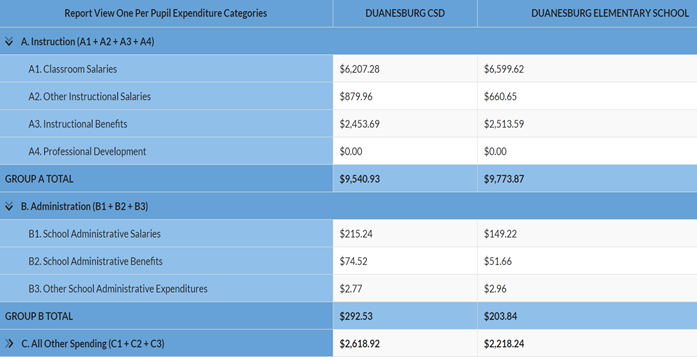FOR IMMEDIATE RELEASE

State Education Department Launches Every Student Succeeds Act Financial Transparency Website
User-Friendly Report Provides Building-Level Data to Learn More About Equity and Effectiveness of Educational Resources
The State Education Department today launched the Financial Transparency Reports website required under the Every Student Succeeds Act (ESSA) plan showing building-level financial information, Interim Commissioner Shannon Tahoe announced. Building-level financial transparency under ESSA will help those interested in education learn more about the equity and effectiveness of our federal, state, and local educational resources. Fiscal transparency reports will outline how much each school is spending per student and the source of the funds—including, for the first time ever, spending data at the individual school level. The data is available now through a user-friendly report included in school and district Report Card on the Department’s interactive public data site.
“In these uncertain times, the Board of Regents and I continue to be focused on ensuring equity in education for every student in New York,” Board of Regents Chancellor Betty A. Rosa said. “Districts face historic financial uncertainty due to COVID-19 and the state’s fiscal crisis. At the district level, this increased transparency will inform our conversations about whether equitable resources are being provided to individual schools for the students who need them.”
“These reports provide important opportunities for school districts, parents and taxpayers and other stakeholders to cultivate a better understanding of school finances and exactly how funding is being used for our students,” Interim Commissioner Tahoe said. “Through greater transparency, we will help spur local discussions about equity, accountability, confirmation of best practices, and opportunities for improvement in financial management and educational programming.”
As required by ESSA, Financial Transparency Reports submitted by every school district outline how much each is spending per student and the source of the funds: federal, state/local. Due to ongoing constraints stemming from the COVID-19 pandemic, the final report will be rolled out in multiple phases. This first phase incorporates the financial data required by ESSA, with additional contextual information. The second phase will incorporate the additional contextual information, as well as statewide average information.
Charter schools currently report actual expenditure data pursuant to section 119.3 of the Commissioner’s regulations, which satisfies the ESSA financial transparency reporting requirements for the 2018-19 school year. Charter schools will begin reporting actual expenditures pursuant to the process outlined in the proposed amendment commencing in the 2019-20 school.
Financial Transparency Reports
For more than two years, the Department has undertaken a rigorous approach of outreach to stakeholders to develop a report template and uniform guidance in submitting expenditure data.
The first phase of the Financial Transparency Reports features data for the 2018-19 school year including economic and student characteristics of each school and district, such as PreK-12 enrollment, Needs Resource Category (NRC), demographics, the district’s ability to raise local funds and the district’s student needs.
Example:

Other data now currently available include:
- Per-Pupil Expenditures by Instruction/Administration/Other: School-level and central district expenditures, including costs for classroom teachers, other instructional salaries and benefits, and administrative salaries and benefits;
- Per-Pupil Expenditures by Local/State and Federal funding sources: School-level and central district expenditures, including school level details for Title I Part A, Title II Part A, Title III Part A, Title IV Part A, IDEA, and all other federal funds;
- Per-Pupil Expenditures in selected program detail areas: School-level and district-level expenditures, including special education, English language learner services, pupil services, community schools programs, BOCES services, and prekindergarten; and
- Total Expenditures and Funds Excluded from Per-Pupil Expenditures such as transportation, charter school tuition, other tuition, debt service, and other categories.
Example:

These and other data can be found within the School Report Card data for each district and school on NYSED’s interactive public data site.
ESSA is Equity
The final approved ESSA plan emphasizes fostering equity in education for New York’s students, expands measures for school support and accountability and student success, and requires school-level improvement plans for the lowest performing schools overall, as well as schools with the lowest performance for certain student populations.
New York State is committed to ensuring that all students succeed and thrive in school no matter who they are, where they live, where they go to school, or where they come from. The plan includes strategies for supporting the professional growth of educators and ensuring that all students, including Multilingual learners/English language learners, immigrant students, migratory youth, students with disabilities, homeless youth, and neglected and delinquent youth, have access to a well-rounded, culturally responsive and sustaining education that supports students’ academic and social-emotional development.
ESSA strategies to foster equity include to: address disparities in training for teachers to help them be effective in the classroom; provide students more access to rigorous high school coursework; make schools equally welcoming environments for all students; increase fiscal transparency in school building spending; and use multiple measures to allow students to demonstrate proficiency in state learning standards.
ESSA also provides states and LEAs with funding to provide additional support to certain groups of students as well as to schools that have been identified for additional support. The plan also ensures that all students receive a culturally responsive and sustaining education that supports their academic and social-emotional development. Additional information on the state’s ESSA plan can be found on NYSED’s website.
Media Contact
Reporters and education writers may contact the Office of Communications by email or phone at:
Press@nysed.gov
(518) 474-1201





